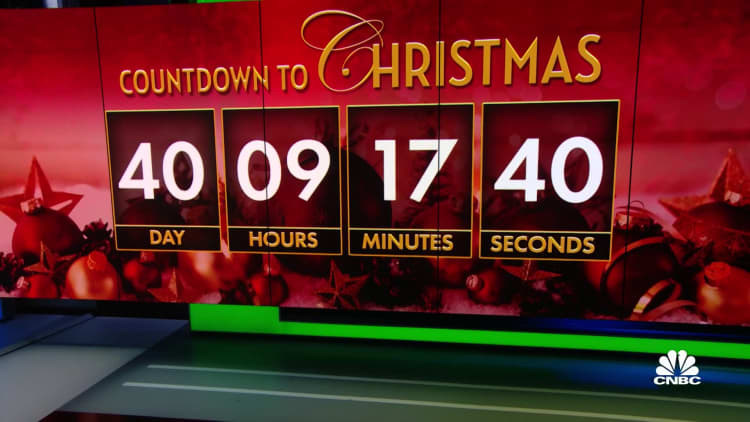[ad_1]
Holiday shoppers take part in early Black Friday shopping deals at the Gap store in Times Square in New York.
Brendan McDermid | Reuters
Gap on Thursday beat Wall Street’s quarterly revenue expectations, but gave a cautious outlook for the holiday season.
The apparel retailer — which includes its namesake brand, Old Navy, Banana Republic and Athleta — said it anticipates its overall net sales could be down mid-single digits year-over-year in the fourth quarter of fiscal 2022.
Chief Financial Officer Katrina O’Connell said while the company made progress in reducing its bloated inventory, it will “continue to take a prudent approach in light of the uncertain consumer and increasingly promotional environment as we look to the remainder of fiscal 2022.”
Shares of the company were up 10% in extended trading Thursday. The stock has fallen 27% so far this year and closed on Thursday at $12.72, up more than 5% during the session.
Here’s how the retailer performed during the three-month period ended Oct. 29:
- Earnings per share: 71 cents adjusted
- Revenue: $4.04 billion vs. $3.8 billion expected, according to Refinitiv consensus estimates.
Wall Street was expecting Gap to break even on a per-share basis, but it wasn’t immediately clear if reported earnings per share were comparable to estimates.
Gap’s net income rose to $282 million, or 77 cents per share unadjusted, a dramatic improvement from a net loss of $152 million, or 40 cents per share, in the year-ago period. Revenue rose 2% to $4.04 billion from $3.94 billion during the same quarter in 2021.
In August, Gap withdrew its full-year guidance, citing company-specific struggles along with high inflation and lower consumer sentiment.
The company is looking for a new CEO after Sonia Syngal departed this summer and playing out a high-profile breakup with Ye’s Yeezy brand. Ye, formerly Kanye West, terminated his contract with Gap in September citing what he called contract breaches and a lack of creative control. Gap removed all Yeezy products from its stores in late October, after West made public antisemitic remarks.
Gap said Thursday it incurred $53 million in impairment charges related to Yeezy Gap.
Comparable sales
The total business’ comparable sales, which track revenue online and at stores open for at least 12 months, rose 1% compared with the year-ago period. Analysts had expected a decline in comparable sales of 3.2%, according to StreetAccount estimates.
Here’s a closer look at each division:
- Gap’s namesake brand, known for denim and basics: comparable sales increased 4% globally and were flat in North America. The company said it got in better shape with inventory, but had weaker sales in the kids and baby categories.
- Old Navy, known for casual clothing for adults and kids: comparable sales fell 1%. The brand saw softer demand for baby and kids’ clothing and got hurt by low-income consumers feeling stretched by inflation.
- Banana Republic, known as a destination for suiting and dresses: comparable sales rose 10%. It’s looking for new direction after the pandemic disrupted the typical fashion routine – causing more people to work from home a few days a week and dress more casually on the days they head into the office.
- Athleta, an activewear brand: comparable sales were flat, as shoppers shifted to buying more outfits for occasions and for work. The business is lapping a time when Americans eagerly stocked up on stretchy leggings, workout tops and other comfortable loungewear when spending time at home.
The retailer is also shaking up its store footprint, based on the banners that are growing or shrinking. So far this year, the company has closed a total of 29 Gap and Banana Republic stores in North America, O’Connell said on a call with investors. It now expects to close about 30 additional stores this year, as part of a goal to close 350 stores in North America by the end of fiscal 2023.
She said the company is on track to open a total of 30 Athleta stores and now plans to open 10 Old Navy stores by the end of this fiscal year.
Inventory improvements
The retailer has been coping with a glut of apparel that’s out of season, out of style or the wrong size.
Bloated inventory has become a problem for many retailers, including Gap. A year ago, Gap struggled to keep up with demand, as factories shut temporarily because of Covid and goods got stuck in congested ports. The retailer went as far as paying extra to fly in apparel by air freight. But delays and backlogs meant some seasonal merchandise still arrived too late.
Inventory has piled up in recent quarters as consumers seek dressier clothes instead of casualwear. Gap’s inventories were up 34% in the first quarter and 37% in the second quarter. Gap been forced to offer deep markdowns, cutting into profits.
At the end of the third-quarter inventories were up 12% as the company continued to pack and hold merchandise to sell another time. The company also saw higher levels of slow-turning basics and some leftover seasonal products, O’Connell said.
She said the company is “committed to getting our inventories cleaned up so that we don’t continue to carry the excess inventory into next year.”
Old Navy has faced a more specific inventory issue: The division decided to offer more plus-sized women’s apparel, but the move wound up leaving stores with too many extended sizes and not enough of popular sizes. Gap said Thursday that Old Navy made strides in the third quarter to improve its balance of sizes, which drove sales.
This story is breaking. Please check back for updates.

Source link



